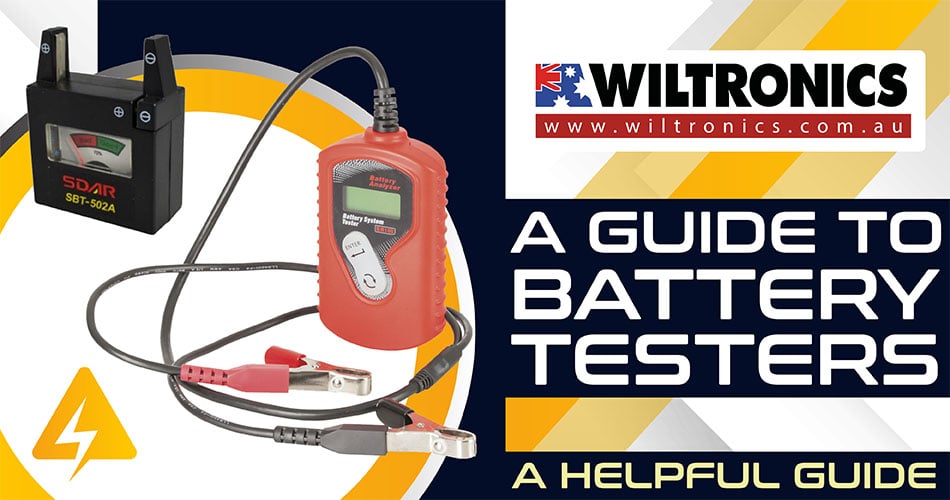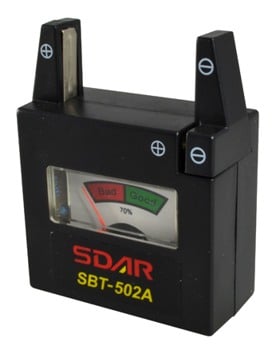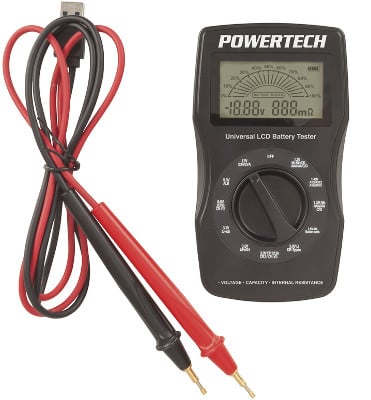How Battery Testers Work - A Guide
March 25, 2022

Most batteries do not come with in-built meters to notify when they are out of power. This is where battery testers come in handy.
Batteries play a major role in everyday life. From mundane devices to electricity in telecommunications, public transportation and medical procedures. Simply put, they are a key part of the energy transition.
So we use battery testers to measure them. But how do these devices work, and how to use one? Keep reading!
What Is a Battery Tester?
Battery testers are designed to test the remaining capacity of a battery’s charge. They work by applying a load and monitoring the voltage response of the battery.
With this, the tester can identify how much power is left. If a battery has a charge, the ink heats up as the current passes through it.
A higher temperature indicates the battery has more current. The gauge from the battery tester usually changes colour based on the temperature.
Current vs charge. The current is the rate of flow of charge, whereas the charge is the physical property of matter. In batteries, the current is what actually charges the battery.
Further, battery testers are ideal for monitoring and troubleshooting. They are, in fact, used across a range of applications and industries, such as:
- Automotive
- DIY and domestic purposes
- Electrical
- Facility maintenance
- Industrial maintenance
- Test and measurement
Convenient to use, these devices provide quick results, making them a must-have tool. Whether you are a DIY enthusiast or professional, a battery tester always comes in handy.
How Does It Work?
As the name suggests, the testers work by testing the current that comes from a battery. Most basic battery testers use conductive ink that responds to minute temperature changes.
When contact is made with both positive and negative contacts on the battery, the current is released. This conductive medium measures the battery charge (amperage). Each tester comes with a gauge that reflects the level of the charge.
Take note, though, that these testers only measure current. On batteries like lithium, the reading results tend to be inaccurate. This is because the current does not wear down evenly. It takes a significant drop at certain charge levels.
Moreover, the batteries will read fully charged even if they only have a half remaining. To test a lithium battery, you need to use a battery conditioner or a tester designed for rechargeable batteries.
As battery testers solely measure current, they provide more accurate readings.
Note: The red one is positive (+), the black one is negative (-). Never connect the red cable to the negative battery terminal or a vehicle with a dead battery. Otherwise, this will cause a full or dead short circuit.
Different Types of Battery Testers
There are different types of battery testers, each suited to varying battery types and sizes.
1. Electronic battery tester
The electronic and digital types are the most common ones used for testing the remaining capacity of a battery. Most digital models feature an LCD, showing the result in a clear and easy to read format.
Depending on the model, the result is displayed in the form of bars or a graph. This enables quick reading and analysis of the test results.
2. Domestic battery tester
Also known as the household battery tester, this type is usually used for testing cylindrical batteries. This includes double and triple A batteries and 9V PP3 batteries.
A domestic battery tester covers the majority of everyday household batteries. It is also suitable for testing a combination of battery types, such as C and D batteries.
These battery testers units are a great example — and are worthy of investment if you are looking for one!
All in One Battery Tester – AAA/AA/C/D/Lithium & Button Cells – No longer available
Product code: JQP2253
The All-In-One Battery Tester can test the battery strength of more than 12 types of batteries. Suitable for standard AA/AAA/C/D/9V batteries, button cells, and lithium batteries, e.g. in digital cameras.
Features an easy-to-read LCD indicating the battery level capacity.

Mini Battery Checker AA, AAA, C, D, 9V & Coin Cells
Product code: ME0806
An inexpensive, compact and convenient battery testing solution. This unit accommodates AAA, AA, C, D and 9V battery sizes and makes testing your batteries a snap.
3. Universal battery tester
Universal battery testers are suitable for batteries in a range of different sizes. Similarly to domestic battery testers, they are primarily used for cylindrical batteries.

Universal Battery Tester
Product code: JQP2260
This lightweight, easy to carry Universal Battery Tester is a simple yet effective model. It works with standard and rechargeable household batteries, including Lithium-based batteries.
With this unit, you can test voltage, capacity, and internal resistance. Plus, it also works with alkaline and various other non-rechargeable batteries.
4. Car battery tester
Car battery testers are intended for use with lead-acid batteries. These testers connect to vehicle batteries to provide a clear sign of the following:
- A car’s battery’s health,
- Condition and
- Voltage output.
Battery testers for automotive applications are important. It is crucial as high currents are drawn during start-up. Ensure that your tester is compatible with lead-acid batteries before use for safe testing conditions.
Have a look at this 12VDC lead-acid battery tester for vehicles below!
12VDC Lead Acid Battery Tester including SLA, AGM, GEL – No longer available
Product code: JQP2261
This battery tester works on all automotive 12V lead-acid batteries. Suitable for testing various battery types, including:
- Ordinary lead-acid battery
- AGM flat plate battery
- AGM spiral battery
- GEL battery
It can quickly and accurately measure the alternator’s charging and starter’s cranking conditions. Plus, it can identify batteries with bad cells.
With reverse polarity protection design and meets major battery testing standards such as:
- CCA
- BCI
- CA
- MCA
- JIS
- DIN
- IEC
- EN
- SAE
- GB
Additionally, this battery tester features an LCD display to indicate the results. It has a menu tab and clips to connect the battery tester to the vehicle’s battery.
How to Use Battery Testers
Each model comes with an instruction manual or manufacturer’s guidelines. We recommend always referring to it before getting started.
Additionally, ensure the tester is fully functioning and compatible with the type of battery you own. After these few pointers, the actual process is relatively simple, with only two steps.
First, insert the battery into the tester. Make sure the positive and negative contacts on both the battery and device match up. Next, secure the battery firmly in place, then take the reading.
After use, store the device in cool, dry conditions such as within your toolbox. This helps maintain and prolongs its lifespan while minimising the risk of damage.
Tip: Do not use a wet cloth when cleaning as this could damage the battery tester. Instead, use a clean cloth or specialised electronics cleaning wipes.
How To Take a Meter Reading?
Once the battery is correctly positioned, you should be able to take a voltage meter reading. Depending on the model you have, the output may vary between different result formats.
If your tester displays a graph or chart, it should be easy to assess the battery’s remaining capacity. But as a general rule, batteries in the green or pointing towards the higher end of the scale are in good working order.
In contrast, batteries with results around the middle of the scale may still be usable for use in sole lower-power applications. Even so, close monitoring will be required.
At last, batteries in the red section or lower end of the scale need to be changed or recharged. They are most likely to have little remaining capacity.
The Bottom Line
The easiest way to check a battery is to use a dedicated battery tester. Suppose you are checking your vehicle battery, use a unit made for automotive testing.
And when purchasing a unit, you must ensure that the tester is compatible with the batteries you have. Additional features will also largely come down to personal preference and requirements.
Some key factors to keep in mind when looking for the best battery tester include:
- Additional features offered
- Compatible battery types
- Price and your budget
As for car battery testers, the unit must be dependable and reliable.
In a nutshell, a battery tester will help you determine if your battery (or car’s) is nearing the end of its usefulness and whether you need to replace it or not.
© Electrotech Brands Pty Ltd 2022


Write a Comment
You must be logged in to post a comment.